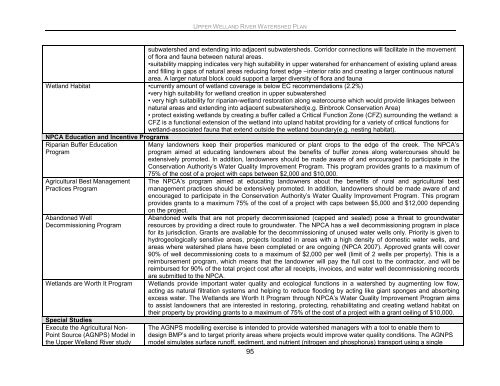Upper Welland River Watershed Plan - Niagara Peninsula ...
Upper Welland River Watershed Plan - Niagara Peninsula ...
Upper Welland River Watershed Plan - Niagara Peninsula ...
Create successful ePaper yourself
Turn your PDF publications into a flip-book with our unique Google optimized e-Paper software.
UPPER WELLAND RIVER WATERSHED PLANsubwatershed and extending into adjacent subwatersheds. Corridor connections will facilitate in the movementof flora and fauna between natural areas.•suitability mapping indicates very high suitability in upper watershed for enhancement of existing upland areasand filling in gaps of natural areas reducing forest edge –interior ratio and creating a larger continuous naturalarea. A larger natural block could support a larger diversity of flora and faunaWetland Habitat •currently amount of wetland coverage is below EC recommendations (2.2%)•very high suitability for wetland creation in upper subwatershed• very high suitability for riparian-wetland restoration along watercourse which would provide linkages betweennatural areas and extending into adjacent subwatershed(e.g. Binbrook Conservation Area)• protect existing wetlands by creating a buffer called a Critical Function Zone (CFZ) surrounding the wetland: aCFZ is a functional extension of the wetland into upland habitat providing for a variety of critical functions forwetland-associated fauna that extend outside the wetland boundary(e.g. nesting habitat).NPCA Education and Incentive ProgramsRiparian Buffer EducationProgramAgricultural Best ManagementPractices ProgramAbandoned WellDecommissioning ProgramWetlands are Worth It ProgramSpecial StudiesExecute the Agricultural Non-Point Source (AGNPS) Model inthe <strong>Upper</strong> <strong>Welland</strong> <strong>River</strong> studyMany landowners keep their properties manicured or plant crops to the edge of the creek. The NPCA‟sprogram aimed at educating landowners about the benefits of buffer zones along watercourses should beextensively promoted. In addition, landowners should be made aware of and encouraged to participate in theConservation Authority‟s Water Quality Improvement Program. This program provides grants to a maximum of75% of the cost of a project with caps between $2,000 and $10,000.The NPCA‟s program aimed at educating landowners about the benefits of rural and agricultural bestmanagement practices should be extensively promoted. In addition, landowners should be made aware of andencouraged to participate in the Conservation Authority‟s Water Quality Improvement Program. This programprovides grants to a maximum 75% of the cost of a project with caps between $5,000 and $12,000 dependingon the project.Abandoned wells that are not properly decommissioned (capped and sealed) pose a threat to groundwaterresources by providing a direct route to groundwater. The NPCA has a well decommissioning program in placefor its jurisdiction. Grants are available for the decommissioning of unused water wells only. Priority is given tohydrogeologically sensitive areas, projects located in areas with a high density of domestic water wells, andareas where watershed plans have been completed or are ongoing (NPCA 2007). Approved grants will cover90% of well decommissioning costs to a maximum of $2,000 per well (limit of 2 wells per property). This is areimbursement program, which means that the landowner will pay the full cost to the contractor, and will bereimbursed for 90% of the total project cost after all receipts, invoices, and water well decommissioning recordsare submitted to the NPCA.Wetlands provide important water quality and ecological functions in a watershed by augmenting low flow,acting as natural filtration systems and helping to reduce flooding by acting like giant sponges and absorbingexcess water. The Wetlands are Worth It Program through NPCA‟s Water Quality Improvement Program aimsto assist landowners that are interested in restoring, protecting, rehabilitating and creating wetland habitat ontheir property by providing grants to a maximum of 75% of the cost of a project with a grant ceiling of $10,000.The AGNPS modelling exercise is intended to provide watershed managers with a tool to enable them todesign BMP‟s and to target priority areas where projects would improve water quality conditions. The AGNPSmodel simulates surface runoff, sediment, and nutrient (nitrogen and phosphorus) transport using a single95
















